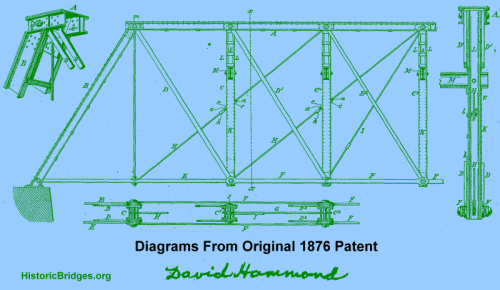We Recommend:
Bach Steel - Experts at historic truss bridge restoration.
BridgeHunter.com Phase 1 is released to the public! - Visit Now
CR-2160 Bridge
TR-268 Bridge

Primary Photographer(s): Nathan Holth
Bridge Documented: April 13, 2013
Rural: Bureau County, Illinois: United States
Metal 8 Panel Pin-Connected Hammond Through Truss, Fixed and Approach Spans: Metal Stringer (Multi-Beam), Fixed
By Builder/Contractor: Wrought Iron Bridge Company of Canton, Ohio
1949
109.0 Feet (33.2 Meters)
176.0 Feet (53.6 Meters)
12.8 Feet (3.9 Meters)
1 Main Span(s) and 3 Approach Span(s)
6400401646

View Information About HSR Ratings
Bridge Documentation
This bridge no longer exists!
View Archived National Bridge Inventory Report - Has Additional Details and Evaluation
This bridge collapsed in a flood due to a failing substructure on April 18, 2013
This bridge was an extremely rare surviving example of a hybrid truss that combines the Whipple and Pratt truss configuration. The main diagonals follow the Pratt configuration, with the counters following the Whipple configuration. This truss design was part of an 1876 patent filed by Wrought Iron Bridge Company owner David Hammond. The company built many truss bridges that list this patent on them, but most of them do not actually follow the hybrid truss configuration displayed in the original patent file, and instead display either a true Whipple or Pratt.
Traditional information sources do not specify a specific name for the truss configuration, however since most truss configurations are named after the person who patented them, HistoricBridges.org lists the truss configuration as the "Hammond" truss configuration.
Be sure to view the Bertram Road Bridge page for the most complete discussion of the Wrought Iron Bridge Company and the Hammond truss configuration.
This was the only known example of a Hammond truss bridge in Illinois, and one of only a few identified to date nationwide. The portal bracing at the south end was not original, but the north end retained original portal bracing including the cast iron portal cresting. It also retained one of the rare cast iron caps on the tops of the end posts that have gone missing on many of the early Pratt truss bridges built by Wrought Iron Bridge Company that included the caps. The date of construction for this bridge is not known, but it likely dated from the late 1870s or into the 1880s.
This bridge was according to the National Bridge Inventory still open as late as 1992, but had since been closed and abandoned. When HistoricBridges.org documented this bridge on April 13, 2013, the bridge trusses were slowly being tipped over by a failing substructure. The substructure, which was not original to the bridge, was an extremely poorly designed combination of steel and timber piles. From the day the substructure was built, it was a cheap and unreliable design, and it didn't last. Some of these piles were sinking, tipping over, or breaking and this was causing the bridge to top over. The angle of the trusses was amazingly far off and the trusses were also twisting significantly, ripping the northern portal bracing off, since the north end substructure was not collapsing in the same way. Less than a week after the field visit, a flood came and the bridge collapsed into the river. This is yet another tragic story of a perfectly good truss destroyed by a bad substructure. There was nothing seriously wrong with the truss, it could easily have been relocated and reused elsewhere prior to collapse. Given the extreme rarity of the truss design, it should have been given the highest preservation priority. That this bridge was not saved from the pathetic substructure it had been allowed to be set upon and was instead allowed to collapse is absolutely shameful. This was one of the most unique historic bridges in Illinois.

![]()
Photo Galleries and Videos: CR-2160 Bridge
Bridge Photo-Documentation
Original / Full Size PhotosA collection of overview and detail photos. This gallery offers photos in the highest available resolution and file size in a touch-friendly popup viewer.
Alternatively, Browse Without Using Viewer
![]()
Bridge Photo-Documentation
Mobile Optimized PhotosA collection of overview and detail photos. This gallery features data-friendly, fast-loading photos in a touch-friendly popup viewer.
Alternatively, Browse Without Using Viewer
![]()
Maps and Links: CR-2160 Bridge
This historic bridge has been demolished. This map is shown for reference purposes only.
Coordinates (Latitude, Longitude):
Search For Additional Bridge Listings:
Bridgehunter.com: View listed bridges within 0.5 miles (0.8 kilometers) of this bridge.
Bridgehunter.com: View listed bridges within 10 miles (16 kilometers) of this bridge.
Additional Maps:
Google Streetview (If Available)
GeoHack (Additional Links and Coordinates)
Apple Maps (Via DuckDuckGo Search)
Apple Maps (Apple devices only)
Android: Open Location In Your Map or GPS App
Flickr Gallery (Find Nearby Photos)
Wikimedia Commons (Find Nearby Photos)
Directions Via Sygic For Android
Directions Via Sygic For iOS and Android Dolphin Browser
USGS National Map (United States Only)
Historical USGS Topo Maps (United States Only)
Historic Aerials (United States Only)
CalTopo Maps (United States Only)


